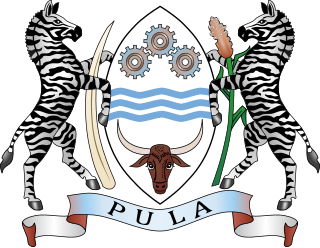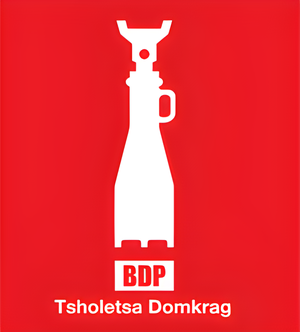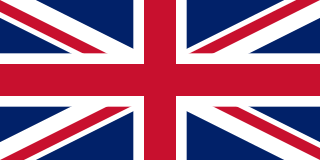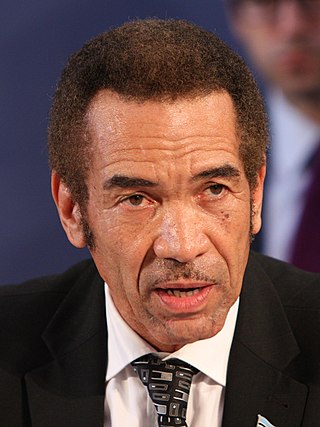Related Research Articles
The history of Botswana encompasses the region's ancient and tribal history, its colonisation as the Bechuanaland Protectorate, and the present-day Republic of Botswana. The first modern humans to inhabit Botswana were the San people, and agriculture first developed approximately 2,300 years ago. The first Bantu peoples arrived c. 200 CE, and the first Tswana people arrived about 200 years later. The Tswana people split into various tribes over the following thousand years as migrations within the region continued, culminating in the Difaqane in the late 18th century. European contact first occurred in 1816, which led to the Christianization of the region.

Botswana is a parliamentary republic in which the President of Botswana is both head of state and head of government. The nation's politics are based heavily on British parliamentary politics and on traditional Batswana chiefdom. The legislature is made up of the unicameral National Assembly and the advisory body of tribal chiefs, the Ntlo ya Dikgosi. The National Assembly chooses the president, but once in office the president has significant authority over the legislature with only limited separation of powers. The Botswana Democratic Party (BDP) rules as a dominant party; while elections are considered free and fair by observers, the BDP has controlled the National Assembly since independence. Political opposition often exists between factions in the BDP rather than through separate parties, though several opposition parties exist and regularly hold a small number of seats in the National Assembly.

Gaborone is the capital and largest city of Botswana with a population of 246,325 based on the 2022 census, about 10% of the total population of Botswana. Its agglomeration is home to 421,907 inhabitants at the 2011 census. Gaborone has per capita income of US$32,000 (PPP), the highest in Africa.

The Botswana Democratic Party is the governing party in Botswana. Its chairman is the Vice-President of Botswana, Slumber Tsogwane, and its symbol is a lift jack. The party has ruled Botswana continuously since gaining independence from the United Kingdom in 1966. The BDP is sometimes classified as a paternalistic conservative party and is also a consultative member of the Socialist International since 2014, which is a group including many worldwide social-democratic parties.

Sir Seretse Goitsebeng Maphiri Khama, GCB, KBE was a Botswana politician who served as the first President of Botswana, a post he held from 1966 to his death in 1980.

The Bechuanaland Protectorate was a protectorate established on 31 March 1885 in Southern Africa by the United Kingdom. It became the Republic of Botswana on 30 September 1966.

The Botswana Defence Force Air Arm is the air force of the Botswana Defence Force. The Air Arm was formed in 1977 and squadrons are designated with a Z, meaning "squadron".
Serowe is an urban village in Botswana's Central District. A trade and commercial centre, it is Botswana's third largest village. Serowe has played an important role in Botswana's history, as capital for the Bamangwato people in the early 20th century and as birthplace of several of Botswana's presidents. More recently it has undergone significant development as the town and as Botswana continues to grow.
Air Botswana Corporation is Botswana's state-owned national flag carrier, with its headquarters located in Gaborone. It operates scheduled domestic and regional flights from its main base at Sir Seretse Khama International Airport. Air Botswana has been loss-making for several years, and there have been various attempts to privatise the company, and frequent changes to the corporation's management and board, so far without reducing the losses.

Sir Seretse Khama International Airport, located 15 kilometres (9 mi) north of downtown Gaborone, is the main international airport of the capital city of Botswana. The airport is named after Sir Seretse Khama, the first president of Botswana. It was opened in 1984 to handle regional and international traffic. It has the largest passenger movement in the country. In 2017 the airport got its first special economic zone which would house in the following departments: CAAB, Botswana Innovation Hub, ITPA and diamond hub for diamond sector.

The Botswana Defence Force is the military of Botswana. The main component of the BDF is the Botswana Ground Force; there is also an air wing and a riverine patrol contingent attached to the ground forces, with 10 Panther airboats and 2 Boston Whaler Raider class.
Louis Matshwenyego Fisher was commander of the Botswana Defence Force (BDF) from 1998 to 2006. He is a recipient of the Légion d'honneur and a Presidential Order of Honour.

Seretse Khama Ian Khama is a Botswana politician and former military officer who was the fourth President of the Republic of Botswana from 1 April 2008 to 1 April 2018. After serving as Commander of the Botswana Defence Force, he entered politics and was Vice-President of Botswana from 1998 to 2008, then succeeded Festus Mogae as President on 1 April 2008. He won a full term in the 2009 election and was re-elected in October 2014.
The history of Gaborone began with archaeological evidence in the area around Gaborone dating back to 400 BCE, and the first written accounts of Gaborone are from the earliest European settlers in the 19th century. Since the 1960s, when Botswana gained its independence from Britain and Gaborone became the capital, the city has grown from a small village in the Botswana scrubland to a major center in southern Africa.

The Botswana Ground Forces is the army of the country of Botswana, and the land component of the Botswana Defence Force.
The Independence Day of Botswana, commonly called Boipuso, is a national holiday observed in Botswana on September 30 of every year. The date celebrates Botswana's Declaration of Independence from the United Kingdom on September 30, 1966.

Semane Setlhoko Khama (1881–1937) was a mohumagadi of the BaNgwato Kingdom in the Bechuanaland Protectorate. Educated in a missionary school, she became a teacher and upon her marriage to Khama III continued to press for education for the BaNgwato. A proponent of modern medicine, she was influential in bringing modern midwifery to the area. As a devout Christian, she encouraged women's involvement in the church and the Woman's Christian Temperance Union.
The History of Botswana includes its pre-state history, its colonial period as the Bechuanaland Protectorate, and its modern history as a sovereign state.
The following lists events that happened during the 1960s in Botswana, beginning with its independence on 30 September 1966.
References
- ↑ Dani Rodrik (2003). In search of prosperity: analytic narratives on economic growth. Princeton University Press. pp. 97–98. ISBN 978-0-691-09269-0 . Retrieved 9 May 2013.
- 1 2 Leith, J. Clark (2005). Why Botswana Prospered . McGill-Queen's Press - MQUP. ISBN 978-0-7735-7241-6.
- 1 2 3 4 5 6 7 8 9 10 11 12 13 14 15 16 17 18 19 20 21 22 23 24 25 26 27 28 29 30 Morton, Barry; Ramsay, Jeff (2018). Historical Dictionary of Botswana (5th ed.). Rowman & Littlefield. pp. xxxiv–xxxv. ISBN 978-1-5381-1133-8.
- ↑ Mwakikagile, Godfrey (2009). Botswana Since Independence. New Africa Press. ISBN 978-0-9802587-8-3.
- ↑ "Botswana profile - Timeline". BBC News. 2017-09-20. Retrieved 2023-09-17.
- ↑ Admin, BFA. "Who we are - BFA". Archived from the original on 2018-03-24. Retrieved 2018-03-23.
- ↑ "Medu Art Ensemble | South African History Online". www.sahistory.org.za. Retrieved 2020-06-08.